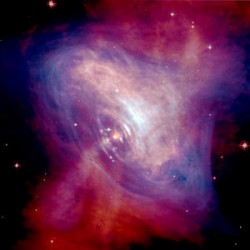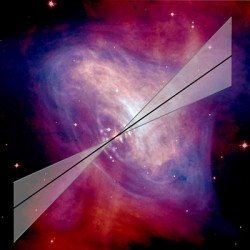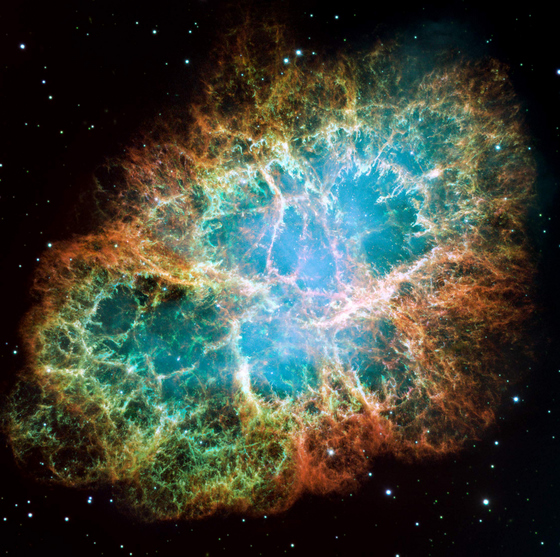[/caption]
Scientists studying the Crab Nebula have discovered high energy gamma rays around the rotation-powered pulsar, the neutron star at the center of this enigmatic nebula. Neutron stars accelerate particles to immense energies, typically one hundred times more than the most powerful accelerators on Earth. Scientists have been uncertain exactly how these systems work and where the particles are accelerated. But by using the gamma-ray telescope on the European Space Agency’s INTEGRAL spacecraft orbiting Earth, astronomers have detected polarized gamma-rays emitting from near the pulsar.
The Crab Nebula was created by a supernova explosion which was seen from Earth by early Chinese and Arab astronomers on July 4, 1054. The explosion left behind a pulsar or rotating neutron star with a nebula of radiating particles around it.

The neutron star contains the mass of the Sun squeezed into a volume of about 10 km radius, rotating very fast – about 30 times a second – thereby generating magnetic fields and accelerating particles. But until now, astronomers didn’t know exactly where the particles were accelerated.
Looking into the heart of the pulsar with Integral’s spectrometer (SPI), the researchers made a detailed study of over 600 observations to assess the polarization – or the alignment – of the waves of high-energy radiation originating from the Crab.
They saw that this polarized radiation is aligned with the rotation axis of the pulsar. So they concluded that a significant portion of the electrons generating the high-energy radiation must originate from a highly-organized structure located very close to the pulsar, very likely directly from the jets themselves. The discovery allows the researchers to discard other theories that locate the origin of this radiation further away from the pulsar.

Professor Tony Dean of the University’s School of Physics and Astronomy, and one of the researchers, commented that the discovery of such alignment – also matching with the polarization observed in the visible band – is truly remarkable. “The findings have clear implications on many aspects of high energy accelerators such as the Crab,†he added.
“The detection of polarized radiation in space is very complicated and rare, as it requires dedicated instrumentation and an in-depth analysis of very complex dataâ€, said Chris Winkler, Integral Project Scientist at ESA.
The paper ‘Polarized gamma-ray emission from the Crab’ is published this week in Science.
More information about the Integral Spacecraft.
Sources: ESA


I always try to imagine what an object like this would look like if we could see it directly from close quarters.
What colour is a neutron star – I suppose we might call this material ‘Neutronium’ (a cold one – I’m talking about reflected light!)?
At a rotation speed of 30 rps, would the shape be a flattened ellipsoid?
And how smooth would the surface of a neutron star be? I imagine it .. very smooth indeed – with variations from a perfect sphere being measured at atomic scales!
@DaveM:
I don’t know about the visibility – it’d be very small, anyway, about 40km across, at twice the weight of our sun… and very hot.
It would certainly be very smooth. I read somewhere that if something or somebody would land on it, they’d be spread out evenly across the surface….
The surface of a neutron star isn’t neutron matter, but rather a layer of iron. Very smooth iron.
This doesn’t necessarily mean it’s shiny metal, though…it’s possible the pressure or electromagnetic conditions on the surface modify its appearance. For example, solid oxygen is normally pale blue, but under sufficient pressure turns dark red. And in sufficiently intense magnetic fields, electron orbitals deform. I have no idea what stretching its orbitals into spindles would do to the appearance of iron…
That’s for a neutron star that’s cooled sufficiently for reflection to be the main way to see it. Neutron stars that actually exist would be blue or violet to the naked eye…assuming you survive the x-rays it radiates most of its energy as, and aren’t blinded by the UV.
Good stuff!
I’m curious as to whether the Fermi GR telescope can measure the polarization of gamma rays. It certainly easily picked up the Crab pulsar in its’ first released all-sky image, although this was a given, taking into account its’ high gamma ray output. Fermi’s higher resolution also may give us more insight into the Crab pulsars’ jet emissions (whether it can detect GR polarity or not).